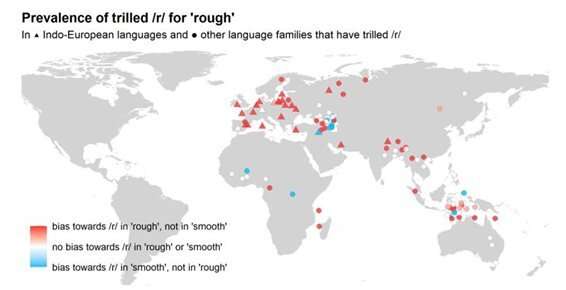‘Rough’ words feature a trill sound in languages around the globe

In languages spoken around the world, words describing rough surfaces are highly likely to feature a “trilled /r/” sound—a linguistic pattern that stretches back over 6,000 years, a new study reveals. The international team of researchers from the University of Birmingham, Radboud University, and the University of British Columbia has published its findings in Scientific Reports.
Language scientists first analyzed words for “rough” and “smooth” in a worldwide sample of 332 spoken languages—discovering a strong link between the sounds of speech and the sense of touch, which has influenced the structure of modern languages.
Compared to words meaning “smooth,” words that mean “rough” were nearly four times as likely to contain a trilled /r/ sound—from Basque “zakarra” and Mongolian “barzgar” to Dutch “ruw” and Hungarian “durva,” these words feature the common sound—an “r” pronounced as an Italian speaker might say “arrivederci.”
Next, they found that the “/r/-for-rough” pattern is prevalent across sensory words in 38 present-day Indo-European languages. It can even be traced to the reconstructed roots of Proto-Indo-European—indicating that the pattern has likely existed in this large language family for more than six millennia.
In the case of English and Hungarian, two unrelated languages, they found that in both languages, some 60% of words for rougher textures, such as “rough,” “coarse,” “gnarled” and “durva,” “érdes,” “göcsörtös” contain an /r/ sound—more than twice as frequent as for words for smoother textures, such as “smooth,” “silky,” “oily” and “sima,” “selymes,” “olajos.”
Association and patterns
Co-author Mark Dingemanse, Associate Professor in Language and Communication at Radboud University, commented, “On their own, any of these patterns would be quite striking, but taken together, they demonstrate a deep-rooted and widespread association between the sounds of speech and our sense of touch.”
“Our findings reveal that the link between ‘/r/’ and roughness comes naturally to us, making the association more likely to surface and to stick around as words evolve over time.”
Co-author Bodo Winter, Senior Lecturer in Cognitive Linguistics at the University of Birmingham, commented, “This is one of the most widespread examples so far of cross-modal iconicity in spoken languages—linking the sounds of speech to the sense of touch. Such cross-modal associations can play a significant role in shaping the forms of spoken words in natural languages—showing that many aspects of language structure are shaped by the human ability to spot and use perceptual analogies that create iconic links between form and meaning.”
Around three-quarters of the world’s spoken languages have an /r/ sound, and the trilled /r/ is the most common variant. Not all languages have a trilled /r/ and some lack these sounds (“rhotics”) altogether. Worldwide, the pattern is found most strongly among those languages that specifically feature a trilled /r/.
Perceptual links between sound and shape may unlock origins of spoken words
Bodo Winter et al, Trilled /r/ is associated with roughness, linking sound and touch across spoken languages, Scientific Reports (2022). DOI: 10.1038/s41598-021-04311-7
Citation:
‘Rough’ words feature a trill sound in languages around the globe (2022, January 20)
retrieved 20 January 2022
from https://phys.org/news/2022-01-rough-words-feature-trill-languages.html
This document is subject to copyright. Apart from any fair dealing for the purpose of private study or research, no
part may be reproduced without the written permission. The content is provided for information purposes only.
For all the latest Science News Click Here
For the latest news and updates, follow us on Google News.

